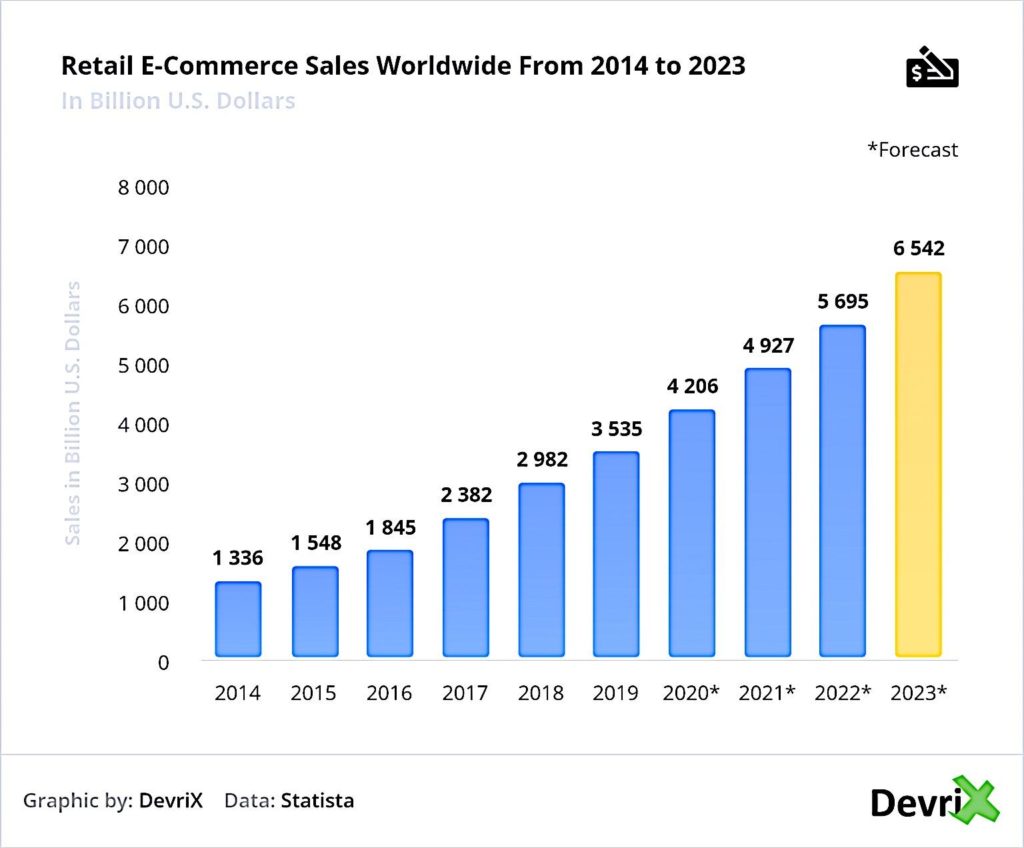The pandemic has caused major drops in the figures of retail shopping, predominantly due to the closure of thousands of shops, many of which have never opened again due to bankruptcy. However, this does not mean that people have started shopping less, but rather they have gone to e-commerce websites instead.
The past decade has witnessed a growth of e-commerce sales of roughly 19% per year, according to Forbes. This shows that despite the fall in retail sales figures, online shopping has proven to be resilient and efficient for millions of consumers around the world.
Why E-commerce sales are on the rise
Due to the restrictions imposed during the COVID-19 pandemic, 2020 saw a surge in people using online shopping to purchase their goods. A study by Adobe shows the percentages of people who had never used the Internet to buy anything before 2020:
- US consumers: 9%
- UK consumers: 15%
- Japanese consumers: 8%
This shows that e-commerce websites have brand-new users who had never used online shopping before the pandemic hit. As the market is growing, Adobe claims that this change is here to stay.
Experts, Oberlo, argue that the rise in e-commerce sales is not just based on the aftermath of the pandemic, but also the rise in the availability of technology. Now, adults of all ages have access to mobile phones or technological devices. Even children have access in this modern age, and are able to send their parents links to the items they want.
Forbes claims that another reason why e-commerce is on the rise is due to search engine optimization (SEO). Previously, companies relied upon search engines to drive customers to their website. However, without the use of SEO, their websites often got lost in a sea of other websites—all competing for the same audience and custom. It was shopping sites such as Amazon and TheFind.com that led the way for other e-commerce retailers. For example, TheFind.com now has over 16 million visitors each month, and these visits have been almost entirely because of SEO.
A further reason for the increase in e-commerce sales is social media. Facebook claims to have 500 million active worldwide users, and 56% of online shoppers use Facebook. Facebook advertising can now drive traffic from their site to others, such as Amazon and eBay. Shoppers also have the ability to post their new purchases online, almost as a free form of advertising for the e-commerce websites and applications.
Ultimately, there are many reasons as to why e-commerce sales are rising at an accelerating pace, not just because of the 2020 pandemic. However, experts from businessinsider.com claim that it did give e-commerce an extra boost. A MasterCard executive added to this, claiming that the pandemic rushed the e-commerce sales to accelerate around two years faster than predictions indicated.
Who generates the highest sales?
According to Cluecommerce, the top Ecommerce sites in the word are:
- Amazon
- eBay
- Alibaba
- Walmart
- JD.com
- Rakuten
- Newegg
- Costco
- Flipkart
- Target
These organizations are from across the world, and it is Amazon that has the highest selling e-commerce retail shop. According to Forbes, Amazon have made approximately $332 billion in 2021, and their net profit through nine months of this year has increased by 35%.
Predominantly due to the Chinese population, Eastern Asia accounts for 60% of retail ecommerce. This results in the sales of $2.8 trillion in 2021. The second most popular place for e-commerce is the US, who account for 13% of all ecommerce sales globally. This means that Asia and North America are responsible for 73% of all ecommerce sales, resulting in the spending of over $3.6 trillion.
Winter sales in 2021
Figures show a decline in sales in November, as sales fell by a record 19.8%. According to the IMRG Capgemini Online Retail Index, this is the lowest growth recorded in their 21-year history.
There is much speculation regarding why sales figures dropped in November, and many experts claim that it is because a lot of buyers started spending their money for Christmas early due to supplier shortages and delivery disruptions.
However, strategy and insight director at IMRG, Andy Mulcahy states that there could be more to the issue than simple early purchases. He claims that the most concerning aspect to it is that traffic dropped. Customers were not visiting websites in their usual numbers, indicating that they were looking for their products elsewhere. Mulcahy goes on to say that it is likely that buyers went to retail shops this November amid fears of another lockdown. He suggests that they may have wanted to go out to buy items whilst they still could, although as yet there is no evidence to support this.
The managing consultant at Capgemini, Lucy Gibbs suggests that the decline is likely to be a combination of all the above factors. She claims that there is no doubt that the supplier shortages have a connection to the low figures.
Predictions
Despite the low figures for November 2021, e-commerce sales are still on the rise and are expected to for years to come.
The graph above demonstrates the rise since 2014, and the predicted rise up to 2023.
Ultimately, e-commerce sales have been on the rise for over a decade, and there are very few signs of it slowing down, despite the occasional slow month such as November 2021.






























